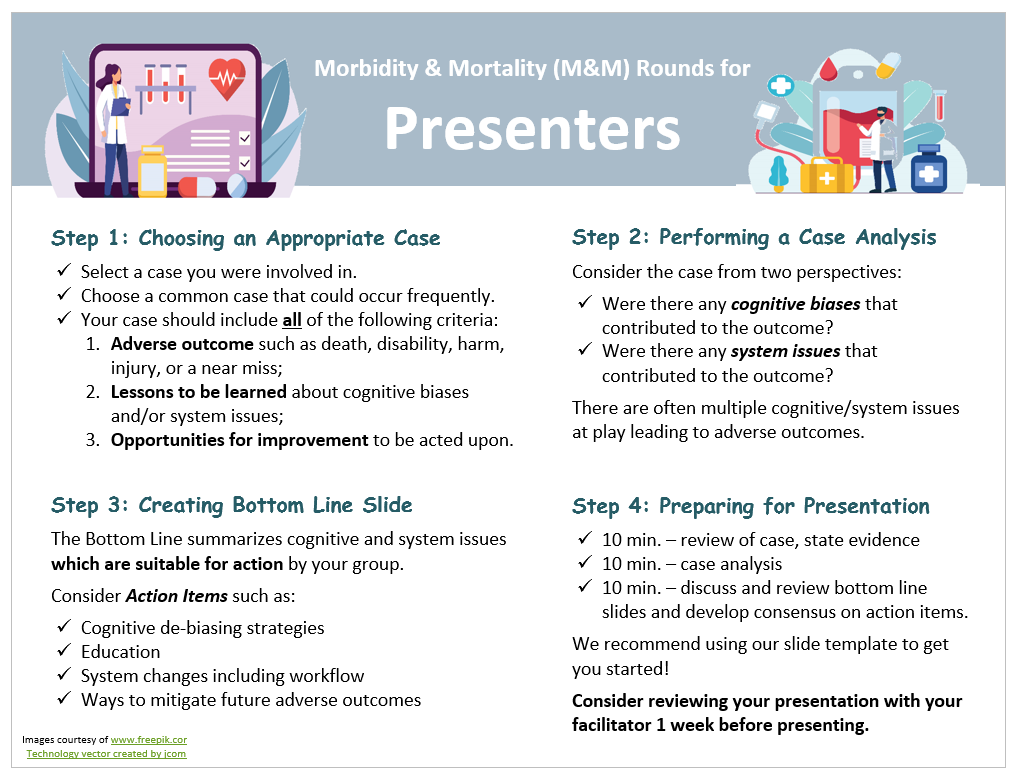Presenters can drive improved quality of care and patient safety by sharing their experiences with adverse outcomes or near misses that contain lessons to be learned about cognitive biases and/or system issues using the structured M&M format.
Common cases that have the potential to occur frequently in your group’s practice setting present an opportunity for change and can improve quality of care.

Island Health also encourages using the M&M format to present “What Works” rounds as an opportunity to celebrate and share successes.
You can learn more about presenting “What Works” rounds including how to select an appropriate case by visiting the M&M Rounds “What Works” Rounds page or reading the Island Health Guide to What Works Rounds.
Steps to Presenting M&M Rounds to Your Group
Whether you put your hand up or were invited to present at you groups M&M rounds, follow these steps to get started.
Familiarize yourself with the Model
Review the Presenter Toolkit for detailed instructions on how to present rounds for your clinical group.
Choose an Appropriate Case
The focus of M&M Rounds is to learn from cases to reduce the chance of similar adverse outcomes or near misses from happening in the future.
Your chosen case should be a common case that you were actively involved in, containing all of the following three criteria:
- Adverse outcome such as death, disability, harm, injury, or a near miss (potential harm avoided - for example, a patient given incorrect medication due to mislabeling of syringe - potential for harm but the patient ultimately wasn’t affected).
- Lessons to be learned about cognitive biases and/or system issues
- Opportunities for improvement can be acted upon
There are many places you can look to when trying to identify a case for presentation at M&M rounds. Potential sources include:
- Cases which cause you to think about them long after they occurred
- Cases which highlight a recurring system issue/frustration
- Cases reported as safety and learning events through the patient safety and learning system (PSLS) or patient care quality office (PCQO).
There is also opportunity to present on a case that celebrates and shares good practices by discussing contributing factors including individual factors, teamwork factors, or environmental/system factors that can be broadly shared to improve quality of care. “What Works” rounds are a tool to acknowledge and celebrate positive moments in healthcare and can contribute to quality improvement through spreading ideas.
Perform a case analysis
Once you have selected your case, your next step is to complete a proper case analysis reviewing your case from two perspectives:
- Were there any cognitive biases that contributed to the outcome?
- Were there any system issues which contributed to the outcome?
More details on how to perform a case analysis and how to identify cognitive biases and system issues are available in the Island Health M&M Rounds Toolkit For Presenters.
A framework for Surgical Specialities is available to assist with performing a case analysis for presenters. This framework was developed in consultation with surgeons to help reframe cognitive and system issues as they relate to specific steps within the Pre-OP/Intra-OP/Post-OP continuum. Click on this link to review the Surgical Speciality Case Analysis Tool.
Remember, you can reach out to your Facilitator any time throughout this process for guidance and support!
Create your bottom line slide
Your bottom line slide summarizes the cognitive and system issues identified during your case analysis that are suitable for action by your group.
When drawing lessons from your M&M rounds case, consider action items that can be made. Examples include:
- Any cognitive de-biasing strategies
- Education regarding evidence, practice guidelines, policies, procedures, use of simulation
- Changes to the system including workflow
- Ways that the adverse outcome in a similar patient could be mitigated
- Please use only your Island Health email to share slides. Non-Island Health emails do not have the same level of security for privacy protection.
Prepare for your presentation
The majority of your time should be dedicated to sharing the findings of your case analysis. The recommendation is to split your session evenly into thirds:
- 10 minutes for review of the case and state of evidence on current management
- 10 minutes for case analysis in terms of cognitive and system issues
- 10 minutes for discussion, review of bottom lines and consensus on potential action items
Using this model, every M&M case presentation should have a few mandatory slides.
Click here for a template to get you started.
Please remember these rounds are confidential and we need to endeavour to protect the privacy of patients. No patient initials, dates, times, or names of staff involved should appear in your presentation. Rounds should be structured under Section 51 of the BC Evidence Act to promote a safe, open and blame-free environment for learning.
Presenting at M&M Rounds
Now its time to present! We recommend connecting with your Facilitator a week before to review your presentation.
 |
Resources for Presenters: Island Health M&M Rounds Toolkit for presenters Identifying cognitive biases and system issues Surgical Speciality Case Analysis Tool Morbidity and Mortality Rounds: Terms of Reference template
|
 |
Are you interested in presenting “What Works” rounds? Visit the M&M Rounds page for What Works rounds to learn more. You can also read the Island Health Guide to “What Works” Rounds for tips on case selection. |
 |
M&M Rounds for Presenters Infographic Island Health M&M Rounds: A Cycle for Change |
Looking for additional information about M&M Rounds at Island Health? Navigate to one of our sub-pages to learn more.
 |
Return to the main Morbidity and Mortality Rounds webpage
|
 |
Visit the M&M Rounds page for What Works Rounds |
 |
|
 |
|
 |
Visit the M&M Rounds at Island Health Resources page for quick links to supporting materials |